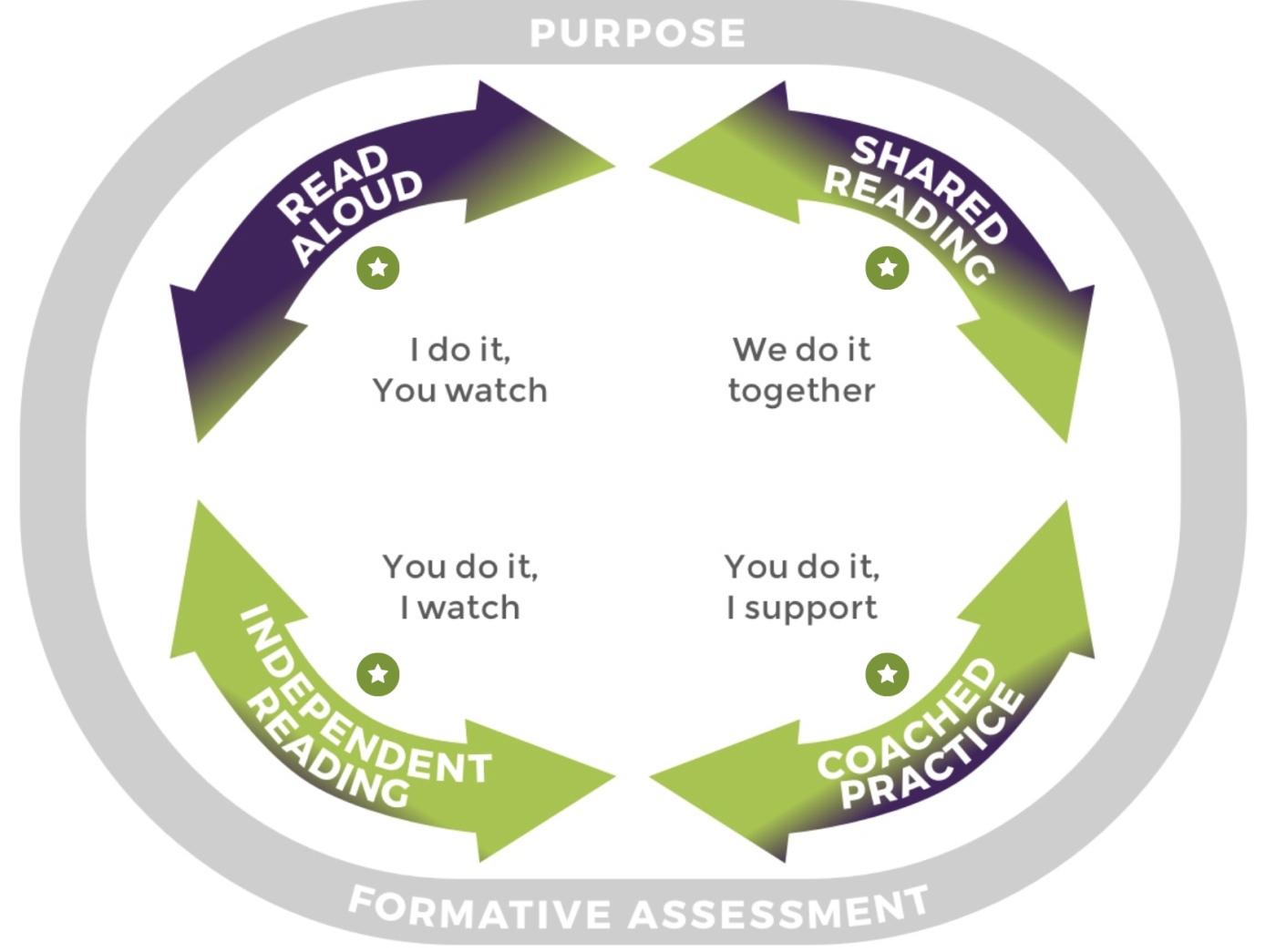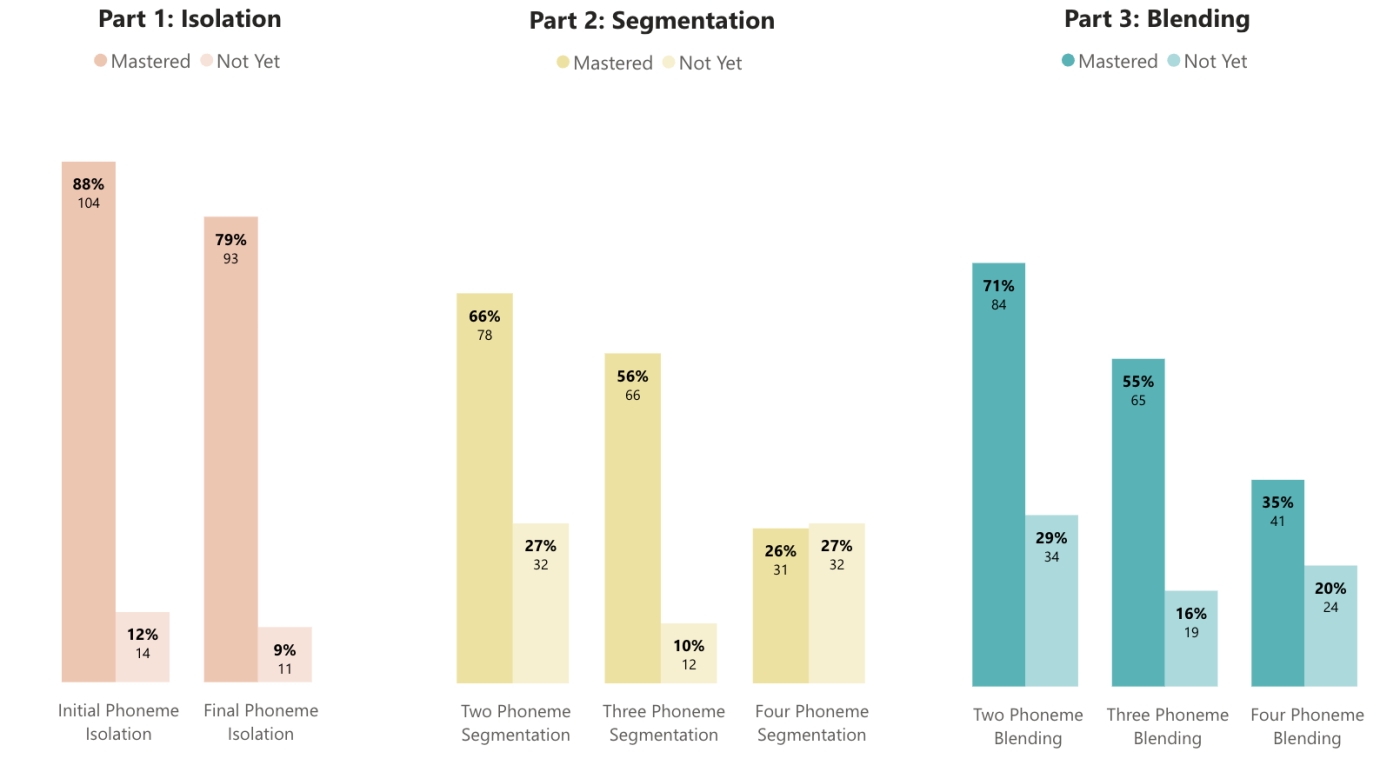Ecole Erma Stephenson Elementary 24-25


OUR CONTEXT
OUR LEARNERS
Fostering a love of reading is a cornerstone to achieving our school's overall goals. Through reading and the English Language Arts Curriculum, students become aware that reading is not just a pathway to academic success, but a gateway to a world of knowledge, personal growth, and critical thinking skills. By developing strong readers, we empower our students to become lifelong learners, capable of navigating information, expanding their horizons, and achieving their full potential.
Staff at Erma Stephenson introduce new reading skills and strategies throughout our students grade K-7 journey. Teachers utilize a "Gradual Release of Responsibility" model as new ideas are introduced and students build confidence as readers and learners. 
Our students understand that language and stories are powerful tools for sparking creativity and joy. Through developmentally appropriate reading, listening, and viewing strategies, they can unlock the meaning of texts, connect with characters and ideas, and use their imaginations to explore new worlds.
Our Super Buddies Reading Program fosters literacy development by pairing grade 6 and 7 students as mentors with younger students. Utilizing the SPARK online reading platform, Super Buddies guide their Super Mentees through engaging stories, exercises, activities, and games. This program strengthens reading comprehension, vocabulary acquisition, and fluency while fostering a love of reading in participants. Super Buddies receive training from Teachers and develop leadership skills, while Super Mentees benefit from personalized support and a positive role model. Our Learner Support Teachers (LST) are the drivers of this program and are quite proud that many of our Mentors are students who once where the Mentees!
Below we see our Super Buddies engaging in an activities to develop their phonological awareness. They also get to connect with an older mentor and build positive relationships within the school community. When asked about the program, our Grade 6 students said:
I really liked reading with the younger students. It was fun!
I had to be organized to make sure we had all the supplies so that I could help them.
I remember learning to read is hard and this was a good way for me to help.

Our learners understand that different texts have different purposes, like a story to entertain or a non-fiction book to share information.
Our learners take part in reading activities and develop their skills throughout the day. One such activity is Literature Circles. A key component to our literature circles is student choice. At Erma Stephenson, we are constantly curating our book selection to provide students with relevant and engaging novel choices. Student choice in novel selection for literature circles within primary and intermediate grades offers a strategic approach to promoting literacy engagement and developing critical thinking skills. By reading a book they are genuinely invested in, students are more likely to actively participate in discussions, analyze characters and plot with greater depth, and cultivate a lifelong love of reading.
Our grade 6 & 7 classes have built a literature circle program in which students are grouped from several different classes in order to meet their learning needs. Below you will see students engaged in discussion with their teacher and each other. These discussions allow for deeper exploration of ideas presented in the novel. Students and teachers collaborate to deepen and share their understanding, explore different ideas and perspectives, and take on roles to develop various reading skills.

Our learners are using developmentally appropriate reading strategies such as using knowledge of language patterns and phonics to decode words, and identifying familiar and “sight” words.
By taking part in the Heggerty Phonemic Awareness Program, students receive explicit instruction on phonemic awareness (the ability to hear and manipulate sounds in spoken language). By understanding sounds and their connection to letters, students develop decoding and encoding skills, which are foundational for reading and writing. Students receive short, daily lessons that target eight phonemic awareness skills alongside letter/sound recognition. Below you will see and hear what these lessons look and sound like in our grade 1 classrooms.
According to our students:
It is fun doing that with our teacher.
Our learners can use various reading strategies to help them think critically, creatively, and reflectively to explore ideas within, between, and beyond texts.
Our upper intermediate students take part in a weekly CNN 10 lessons. During this activity, they watch a student friendly summary of the weekly news. They are encouraged by their teachers to think deeply, question the information being presented, and to reflect on their thinking. Below, you see an example of "deep dive" questioning, by one of our students, into the topics being covered. Some of our upper intermediate students also give presentations and engage their classmates in current event discussions. As our students progress from kindergarten to Grade 7 and beyond, they develop their reading & thinking skills and move along a continuum. What begins with letter recognition and letter sounds, grows into critical thought and analysis as our students develop their reading and thinking skills.

When asked "What value do you see in studying current events and CNN10?", student responses included,
The videos are interesting and make the news understandable for students.
It helps me be aware of what is happening in the world.
When my friends give presentations, it helps me understand the issue better.
OUR FOCUS
We not only want to develop a love of reading for enjoyment in our students, but also the ability the critically analyze the information they will be presented throughout their lives. In today’s world, students are bombarded with information from a variety of sources, including websites, social media, and videos. Being able to critically evaluate this information is essential. Strong reading skills provide a foundation for this, as they allow students to analyze information they are being presented.
Our learning goals for this cohort include:
- Our learners are building strong foundational literacy skills, recognizing letters, sounds, and simple sight words.
- Our learners use developmentally appropriate reading, listening, and viewing strategies to make meaning.
- Our learners use sources of information and prior knowledge to make meaning.
Our Cohort:
We chose to follow a grade 1 classroom cohort to help us assess the long-term impact of our school goals on core academic skills. As we are still in the early stages of a Literacy based Learning Plan, we have decided to continue with an early primary classroom. As this cohort has several years left in the school, it allows for the possibility of seeing the long-term impact of reading programming and interventions at Erma Stephenson. Focusing on grade 1 specifically allows us to address the crucial foundation of early literacy. By fostering collaboration among grade 1 teachers, we can ensure a consistent and cohesive approach to reading instruction, ultimately improving literacy outcomes for all students.
Term 1: September – December
During the first term, students were focusing on reading CVC (consonant-vowel-consonant) words through word lists and stories. By practicing these basic word patterns, students were developing foundational reading skills necessary for future reading success. These skills include:
Phonemic Awareness: The ability to hear and manipulate individual sounds in words.
Letter-Sound Knowledge: Recognizing the sounds that correspond to each letter.
Blending: Putting individual sounds together to form words.
Fluency: Gaining confidence with both real and nonsense CVC words, which will later help with decoding longer, multisyllabic words like mag/net and fan/tas/tic.
The goal is fluency with short-vowel words. Fluency means being able to read words accurately and automatically, without pausing to sound them out. Fluent reading will enable students to focus on what they are reading, allowing them to enjoy stories and gather information with ease.
Term 2: January - March
Our cohort began exploring a range of reading materials, including levelled readers, phonics-based decodable stories, shared reading big books, and classroom library books. They continued to build their sight word vocabularies and applied their growing phonetic skills to decode unfamiliar words. In addition, they focussed on essential decoding and comprehension strategies to deepen their understanding of the texts they encounter.
Decoding Strategies
- Stretch out letter sounds, then blend them together (th-ir-d, third).
- Identify familiar chunks in words, such as blends (fr, st), digraphs (th, sh, ch), and common word endings (ing, ed, er, y says e, and y says i).
- Look for smaller words or readable chunks inside multi-syllabic words (forget = for + get), (discovery = dis + cov + er + y says e).
- Remove endings like ed, er, ing, and ly to reveal the root word (helped: help, softly: soft).
- Flip the vowel sound if the short vowel doesn’t create a meaningful word; try the long vowel sound instead (wind, wind), (live, alive), (read, read).
Comprehension Strategies
Before Reading:
- Our cohort was encouraged to take time to look at the title and think about the topic before they start reading. This helps them connect their prior knowledge to the text, making it easier to predict and understand new words as they read.
While Reading:
- They are reminded to pay attention to the story and check if it makes sense by asking themselves, "Does this make sense?" If they encounter something confusing, they are reminded to go back and reread to clarify the meaning.
After Reading:
- Rereading helps children strengthen vocabulary, improve fluency, and boost their comprehension. They show us their understanding by:
- Answering questions and discussing the text.
- Retelling the story in their own words.
- Describing the characters and setting.
- Identifying the problem and solution in the story.
Term 3: April - June
Reading for Meaning
During the final term in reading, our cohort focussed on “Reading for Meaning.” As the students began to do more independent reading, it was crucial that they focus not only on reading words but also on understanding what they are reading. They learned comprehension strategies that can help them understand what they read more clearly. Finally, they built comprehension through active strategies. Students also practiced applying strategies like making text-to-self connections, summarizing key details, and asking clarifying questions to deepen their understanding of grade-level texts.
Some sample strategies:
- Think about what you already know about the topic.
- Make a connection between the topic and your own life.
- Stop and take the time to decode unknown words.
- Ask for help if you need it, because you want all the words to make sense as you read and you want to add new words to your reading vocabulary.
- Reread several times to develop fluency and expression. Steady, smooth, expressive reading helps you understand what you are reading.
- Read books about topics and characters that interest you!
- Read books you understand so you enjoy reading them!
- Listen to yourself as you read!
OUR NEXT STEPS
Our School's Learning Goals this year included:
- Use sources of information and prior knowledge to make meaning.
- Use developmentally appropriate reading, listening, and viewing strategies to make meaning.
- Building strong foundational literacy skills, recognizing letters, sounds, and simple sight words.
At Erma Stephenson, we have committed to gathering data to inform our decision making process . This data comes from many sources, including mandated Provincial Assessment, District Level Assessment, and classroom-level teacher expertise assessment. Our job is to analyze this data with our staff and decide the best course of action to improve student outcomes in Reading Comprehension.
Below you can see data from various sources including the FSA, ELPATS, and Teacher Assessments.
Our Data:
Our Grade 1 Cohort
The data in the following table is based on the Acadience Reading Assessment:
This year, our Cohort Class used the Acadience Reading Assessment to monitor the progression of our students. Acadience Reading is a quick and reliable tool that helps teachers understand how students are developing key reading skills, such as sounding out words, reading smoothly, and understanding what they read. It’s used from kindergarten through grade 6 and is designed to be short, one-on-one, and developmentally appropriate.
Importantly, Acadience is not a test that gives a final grade or label. Instead, it’s a way for teachers to gather information that helps guide their instruction. The goal is to identify students who may need extra support early on, so we can adjust our teaching to meet their needs and help them grow as readers.
At our school, we use Acadience Reading data to shape our classroom strategies, set meaningful goals, and monitor progress over time.

FSA: Foundational Skills Assessment
The Foundational Skills Assessment (FSA) is an annual province-wide assessment administered to all students in grades 4 and 7 in British Columbia. This assessment evaluates students' proficiency in key areas of literacy and numeracy. The FSA provides valuable data to parents, teachers, schools, school districts, and the Ministry of Education, offering insights into how well students are progressing in these foundational skills
The primary purpose of the FSA is to gather data that helps the province assess the overall performance of students in these critical areas. This information is used to inform educational strategies and policies aimed at improving student outcomes across British Columbia.
While the FSA is an important tool for measuring student performance, it is recognized that it represents a single assessment at a specific point in time. As such, it may not fully capture the true abilities and potential of our students. At our school, we place significant value on the ongoing, day-to-day assessments and data collection conducted by our dedicated staff. These formative and summative assessments provide a more comprehensive and nuanced understanding of each student's learning journey and achievements (see further down this page for that data).


ELPATS: Early Literacy Phonemic Awareness Tool Surrey
The ELPATS is a formative assessment tool designed for classroom teachers to monitor learners' development of phoneme-level phonological awareness skills. The skills included in the ELPATS are informed by research to be the most critical phonemic awareness skills for reading and writing success. Assessment commences in kindergarten with periodic monitoring through the primary years until mastery of each skill is achieved.

The following data is a summary of students in Kindergarten, Grade 1 and Grade 2 mastery of phonological awareness skills at Erma Stephenson Elementary.

School Wide Teacher Expertise Assessment
This year, we asked teachers to use their professional knowledge, summative assessments, and understanding of their students to assign each student an indicator using our district standard Proficiency Scale.
(The data below represents our students as of May 2025. Moving forward, we will collect data each October and May in order to track long-term trends across our school.)
Erma Stephenson Whole School Reading Comprehension Proficiency. May 2025

In Summary:
At our school, we use a range of assessments to support student learning. The ELPAT and Acadience assessments are formative tools that help teachers monitor student progress throughout the year and adjust instruction based on individual needs, especially in language and literacy development. In contrast, the Foundation Skills Assessment (FSA) and Teacher Assessment are summative tools that provide a snapshot of how students are performing in reading at a specific point in time. Together, these assessments give us a well-rounded view of student learning and achievement.
In the same way that our teachers use summative assessment when writing report cards, we use our summative data when analyzing our reading results this year.

Our summative assessment data (see above) shows that many of our students are on track or exceeding expectations in their reading abilities. This is a positive reflection of the hard work of our students and staff, and the strong literacy foundation we’ve built together.
At the same time, we are cognisant that their is always room to grow. We’re committed to helping all our students continue to develop their reading skills, and we’ll keep working on strategies and supports to ensure all learners can thrive.
Moving Forward:
This year we were able to gather year end school wide reading comprehension levels. Next year, we are excited to gather beginning of year and end of the year reading comprehension levels in order track student growth. We are also excited to adapt the British Columbia Reading Performance Standards to provide simple grade-level and school specific assessment language to our teachers and students.
We will continue working towards our previously stated goals.
Our students understand that language and story can be a source of creativity and joy
- Continue to provide a variety of engaging and at their level books to our students
Our students understand that questioning what we hear, read, and view contribute to our ability to be educated and engaged citizens
- Continue to provide a variety of relevant, current and at their level reading opportunities to our students
Our students can use sources of information and prior knowledge to make meaning. Our students can use developmentally appropriate reading, listening, and viewing strategies to make meaning. Our students can build strong foundational literacy skills, recognizing letters, sounds, and simple sight words.
- Continue to develop instructional strategies (professional book clubs and professional development opportunities) that will allow students to develop reading strategies.
